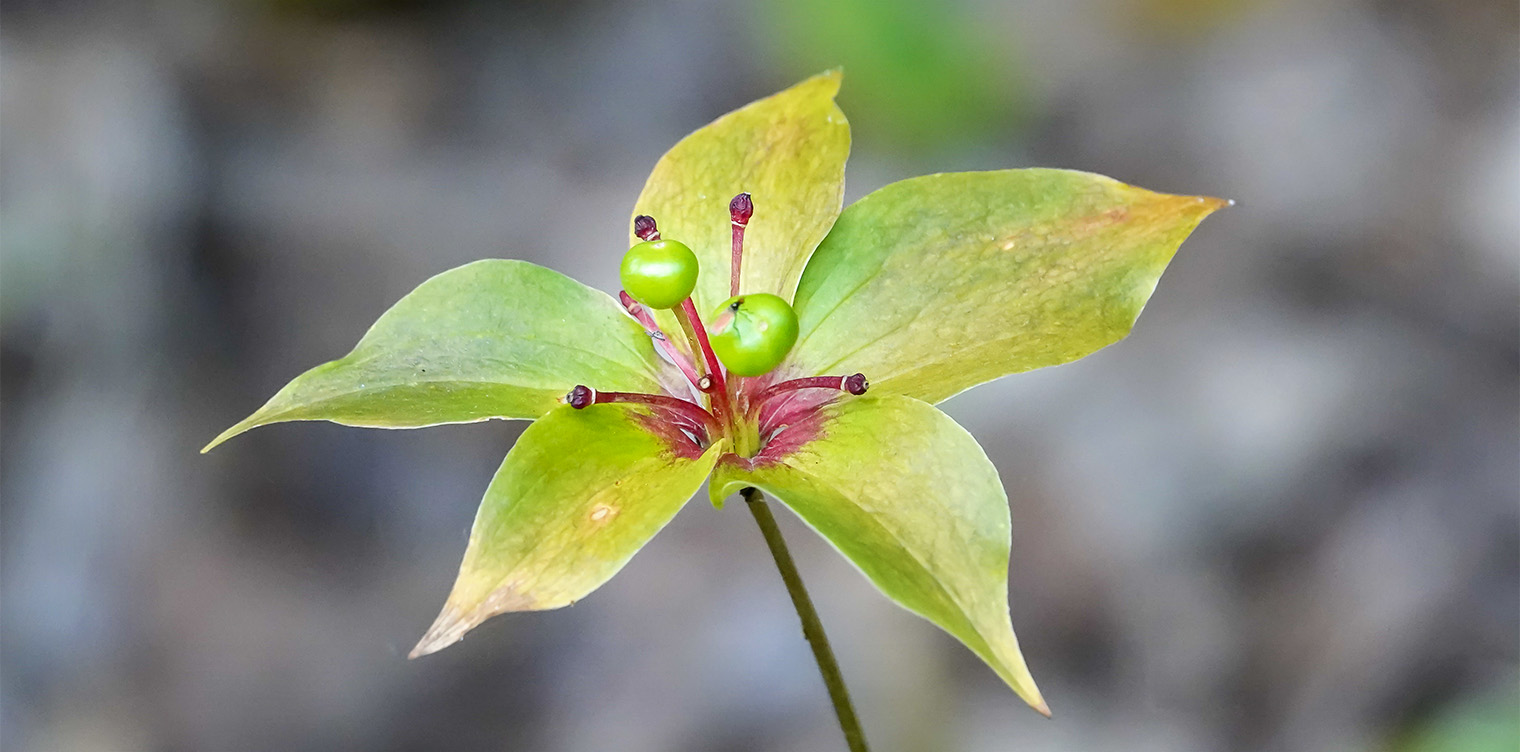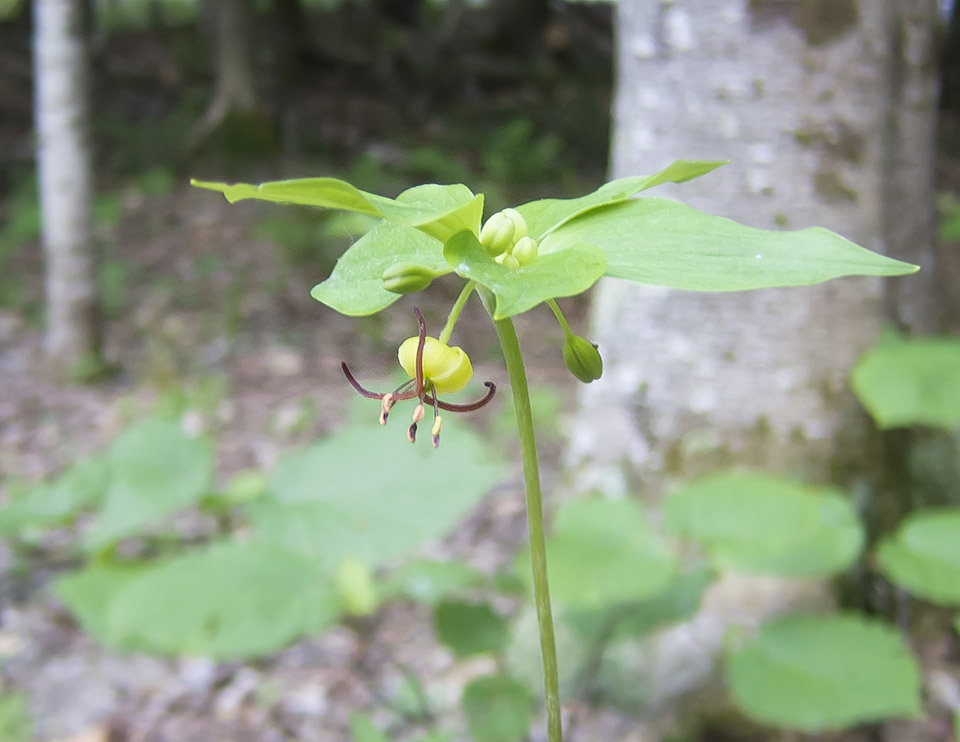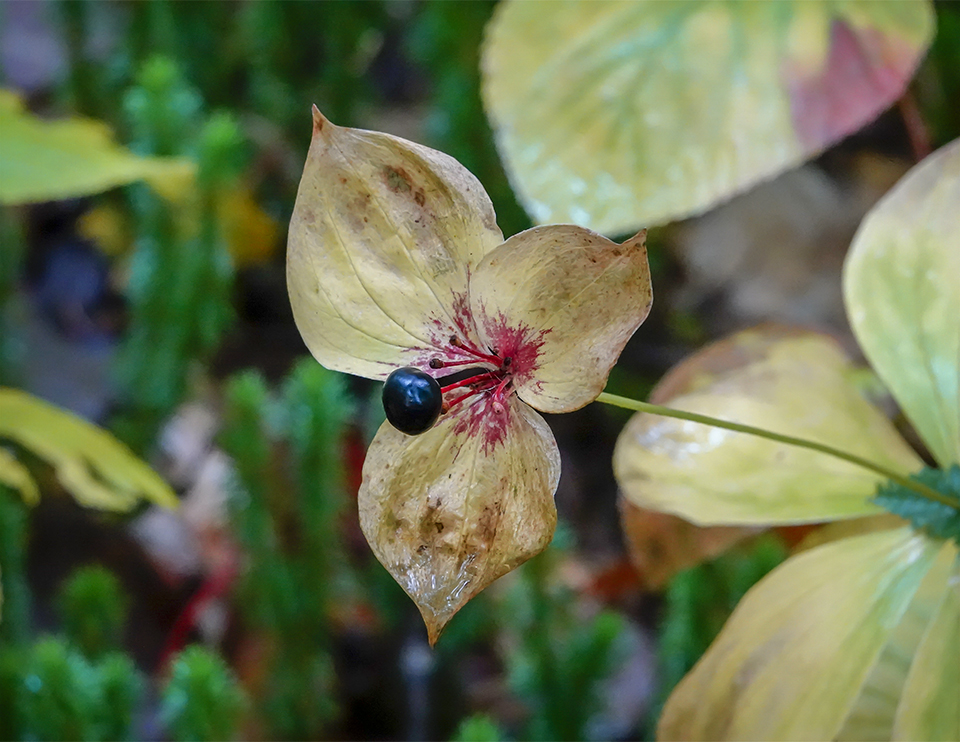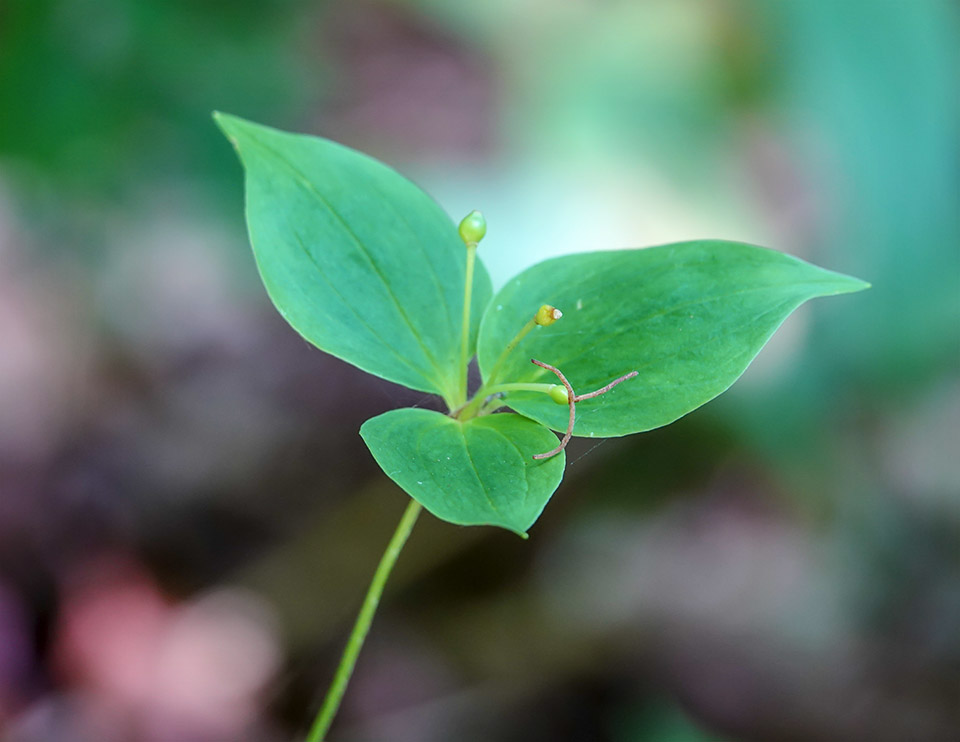Wildflowers of the Adirondacks:
Indian Cucumber-root (Medeola virginiana)

Indian Cucumber-root (Medeola virginiana) is a native wildflower that produces small, greenish-yellow flowers in late spring. It grows in moist woodlands in the Adirondack Mountains of upstate New York.
Indian Cucumber-root is a member of the Lily (Liliaceae) family. The common name stems from the fact that the root tastes and smells somewhat like a cucumber and was used for food by native Americans. The plant is now quite scarce. The plant is also known as Indian Cucumber. The genus name (Medeola) refers to the sorceress Medea from Greek mythology; this is apparently a reference to the plant's medicinal uses.
Identification of Indian Cucumber-root

Indian Cucumber-root is an erect plant which grows one to two feet tall and has hairy, unbranched stems. The root of the Indian Cucumber-root consists of thick, tuber-like rhizomes, which have a brittle texture.
The leaves are whorled and lance-like, with pointed tips. Indian Cucumber-root is two-storied, with two tiers of leaves. Plants that are going to flower have two tiers of leaves. The upper whorl overhangs the flowers. Non-blooming plants have only the lower tier.
The foliage of one-tiered Indian Cucumber-root plants resemble that of Starflowers. However, the veins of the Starflower are pinnate, meaning that there is one main vein running from the base of the leaf to the tip, with secondary veins branching off at intervals. By contrast, the veins of an Indian Cucumber-root leaf are parallel, with the curving veins run parallel from the leaf base to the tip.
The inconspicuous greenish to yellow nodding flowers emerge from the center of a whorl of three leaves at the top of a slender, woolly stem. The flowers are 1/2 inch wide and appear on stalks that sometimes bend down below the leaves. The flowers have petal-like segments with turn backward. The flowers are hermaphrodite (have both male and female organs). The stamens are red to purplish.

Indian Cucumber-root usually blooms in the Adirondack Park in June, depending on the weather. A tally of flowering dates for the upland Adirondack areas compiled by Michael Kudish, based on data collected from the early seventies to the early nineties, lists the earliest flower date as 5 June and the median date as 12 June. Data from recent years suggest similar bloom times. You can usually find Indian Cucumber Root in bud in late May.
The flowers are followed by fruit. The berries appear in late July, starting out green. They eventually turn a striking bluish-purple. The berries stand out against a background of yellow foliage, splashed with crimson.
Uses of Indian Cucumber-root
The root of this species is edible and tastes somewhat like a cucumber. However, Indian Cucumber-root should not be collected and consumed for environmental reasons, since it is not an abundant plant.
Wildlife Value of Indian Cucumber-root
No wildlife uses for this species were found.
Distribution of Indian Cucumber-root

Indian Cucumber-root can be found in the eastern half of the US and Canada, Ontario, Quebec, and Nova Scotia; south to Florida; west to Alabama and Louisiana; north to Minnesota. The plant is categorized as endangered in Illinois and Florida.
Indian Cucumber-root is found in practically all New York State counties, including all counties within the Adirondack Park Blue Line.
Habitat of Indian Cucumber-root
Indian Cucumber-root grows in shade or partial shade on moist slopes and in well-drained to moist hardwood and mixed wood forests. It appears to decline in abundance after disturbances. For instance, in the Forest Ecosystem Research and Demonstration Area (FERDA) at the Paul Smiths VIC, an inventory of plants taken a decade after logging operations showed a decline in abundance for Indian Cucumber-root on two of the five logged blocks (clear cut and shelterwood).
In the Adirondack Mountains, Indian Cucumber-root is found in several ecological communities, including Beech-Maple Mesic Forest, Hemlock-Northern Hardwood Forest, and Spruce-Northern Hardwood Forest. Look for Indian Cucumber-root along several trails covered here, including the Boreal Life Trail, Barnum Brook Trail, and Heron Marsh Trail at the Paul Smith's College VIC, the Maple Grove Trail at John Brown Farm, the Boundary Trail at the Peninsula Nature Trails, the Heart Lake Trail, and the Big Field Loop at Heaven Hill.
References
Michael Kudish. Adirondack Upland Flora: An Ecological Perspective (The Chauncy Press, 1992), pp. 26, 230.
New York Flora Association. New York Flora Atlas. Indian cucumber-root. Medeola virginiana L. Retrieved 15 April 2017.
United States Department of Agriculture. The Plants Database. Indian Cucumber. Medeola virginiana L. Retrieved 15 April 2017.
Flora of North America. Medeola virginiana Linnaeus. Retrieved 15 April 2017.
iNaturalist. Adirondack Park Sightings. Indian Cucumber-root. Medeola virginiana. Retrieved 28 June 2021.
NatureServe Explorer. Online Encyclopedia of Life. Indian Cucumber-root. Medeola virginiana - L. Retrieved 15 April 2017.
New York State. Department of Environmental Conservation. New York Natural Heritage Program. Ecological Communities of New York State. Second Edition (March 2014), pp. 119-120, 121, 123. Retrieved 17 October 2015.
New York Natural Heritage Program. 2021. Online Conservation Guide for Beech-Maple Mesic Forest. Retrieved 28 June 2021.
New York Natural Heritage Program. 2021. Online Conservation Guide for Hemlock-Northern Hardwood Forest. Retrieved 28 June 2021.
New York Natural Heritage Program. 2021. Online Conservation Guide for Spruce-Northern Hardwood Forest. Retrieved 28 June 2021.
New York State. Adirondack Park Agency. Preliminary List of Species Native Within the Adirondack Park Listed Alphabetically by Scientific Name and Sorted by Habit. Volume 1. Updated 10.23.2006, p. 28. Retrieved 26 January 2017.
Connecticut Botanical Society. Indian Cucumber Root. Medeola virginiana L. Retrieved 15 April 2017.
University of Wisconsin. Flora of Wisconsin. Medeola virginiana L. Retrieved 15 April 2017.
Lady Bird Johnson Wildflower Center. Medeola virginiana L. Retrieved 15 April 2017.
Mark J. Twery, et al. Changes in Abundance of Vascular Plants under Varying Silvicultural Systems at the Forest Ecosystem Research and Demonstration Area, Paul Smiths, New York. USDA Forest Service. Research Note NRS-169, p. 7. Retrieved 22 January 2017.
Plants for a Future. Medeola virginiana - (L.) Merrill. Retrieved 15 April 2017.
University of Michigan. Native American Ethnobotany. A Database of Foods, Drugs, Dyes and Fibers of Native American Peoples, Derived from Plants. Medeola virginiana L. Indian Cucumberoot. Retrieved 15 April 2017.
Ruth Schottman. Trailside Notes: A Naturalist's Companion to Adirondack Plants (Adirondack Mountain Club, 1998), pp. 69-72.
Doug Ladd. North Woods Wildflowers (Falcon Publishing, 2001), p. 239.
Lawrence Newcomb. Newcomb's Wildflower Guide (Little Brown and Company, 1977), pp. 352-353.
Roger Tory Peterson and Margaret McKenny. A Field Guide to Wildflowers. Northeastern and North-central North America (Houghton Mifflin Company, 1968) pp. 102-103.
National Audubon Society. Field Guide to Wildflowers. Eastern Region. (Alfred A. Knopf, 2001), pp. 609-610.
William K. Chapman, et al. Wildflowers of New York in Color (Syracuse University Press, 1998), pp. 92-93.
Anne McGrath. Wildflowers of the Adirondacks (EarthWords, 1981, 2000), p. 75, Plate 20.
Steven Foster and James A. Duke. Medicinal Plants and Herbs of Eastern and Central North America (Houghton Mifflin Harcourt, 2014), pp. 141-142.
Lee Allen Peterson. A Field Guide to Edible Wild Plants. Eastern and Central North America (Houghton Mifflin Company, 1977), pp. 74-75.
Bradford Angier. Field Guide to Edible Wild Plants. Revised and Updated. (Stackpole Books, 2008), pp. 102-103.
Nancy G. Slack and Allison W. Bell. Adirondack Alpine Summits: An Ecological Field Guide (Adirondack Mountain Club, Inc., 2006), p. 20.
Charles H. Peck. Plants of North Elba. (Bulletin of the New York State Museum, Volume 6, Number 28, June 1899), p. 133. Retrieved 22 February 2017.
